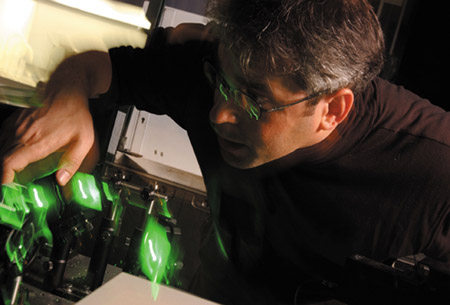 |
|
|||||||||
|
David Grier’s optical vortices may be an answer for everything from making nanorobots to curing cancer. Chicago physicist David Grier’s latest work has given a new twist to optical vortices: rings of light that rapidly spin microscopic particles suspended in water around the rings’ circumference. Using a technology he coinvented in 1997—holographic optical tweezers (HOT), or computer-generated holograms that create large optical traps that can suspend particles in three dimensions—Grier twists ordinary, microscopic light beams into a corkscrew pattern. Generating 200 twists in the corkscrew—far exceeding the eight or fewer twists that other methods of creating optical vortices have produced—Grier and his colleagues can control and tune the beam precisely.
“Other optical traps grab things. This trap allows you to grab something and exert a twist as well,” Grier says. “You can exert both a force and a torque.” This level of precision allows Grier to create microscopic pumps that direct fluid flow with an array of rapidly spinning particles trapped in one or more light rings. As a particle makes its way around the light ring’s circumference, it traverses a slope dotted with hills and valleys. Every time the particle falls into a valley, it loses a bit of energy and becomes trapped until random thermal forces kick it over the hill and into the next valley. At the end of one rotation it’s back where it began. “It’s forever taking steps downward and coming back to where it started,” Grier says, “just as in Escher’s impossible staircase,” referring to M. C. Escher’s famous 1960 lithograph. In Ascending and Descending, monks tread a continuous staircase that brings them back to their starting point after making a complete circuit. “Escher’s staircase works through a trick of perspective,” Grier says. “Ours works through a trick of statistical mechanics.” Besides creating unexpected, seemingly impossible phenomena, the optical vortices also have practical applications. Grier and Jennifer Curtis, PhD’02, recently measured the vortices’ spin, publishing their findings in the April 4 Physical Review Letters. Understanding how the vortices exert torques is an important step toward harnessing their energy—created by orbital angular momentum—to power microelectromechanical systems (MEMS). These systems, Grier hopes, may lead to the production of such futuristic devices as nanorobots and laboratories on a microchip, bringing together silicon-based microelectronics with micromachining technology. The problem with current MEMS devices is that they need a motor. Although many motors have been tried, Grier says, they all “go a little bit slowly and they wear out very, very fast.” Optical vortices need no microfabricated motor. In fact, they have no moving parts. “You can just project an optical vortex onto the device,” Grier says, “and away it will go.” Also using HOT technology Grier has created a technique called optical fractionation, which he described at a March American Physical Society press conference. This process selectively sorts microscopic particles, biological cells, and large molecules. Researchers may, for example, use optical fractionation to separate cancer cells from others, based on the cells’ stiffness. “Cancer cells tend to be softer than normal,” Grier explains. “This [fact] wasn’t our discovery, but we can exploit it.” A similar approach may purify pharmaceuticals, including anticancer drugs. The 40-year-old Grier, who earned his bachelor’s at Harvard and his Ph.D. at Michigan, joining the Chicago faculty in 1992, first encountered optical tweezers more than a decade ago while doing postdoctoral research at AT&T Bell Labs. A scientist there demonstrated the technique to Grier, who then found that, using the principle that small particles illuminated by a focused light beam are drawn to the light’s brightest point, the tweezers could trap a particle and move it around in three dimensions—“just like a Star Trek tractor beam.” With earlier optical tweezers scientists needed to generate a separate light beam for each particle they wanted to manipulate. Because the elaborate system of light-splitting equipment soon became both expensive and unwieldy, Grier and Eric Dufresne, SM’98, PhD’00, developed the HOT technology at Chicago. “We were inspired by a cheap diffractive beamsplitter sold as a toy for laser pointers for about $5,” Grier says. He doubted the device would work for optical tweezers, “but for five bucks,” he figured, “why not give it a try?” In fact, it worked on the first attempt. “That’s when we knew that our approach was really robust and probably worth patenting.” The next step, Grier says, was to make the system dynamic “so that all of the traps can move around.” Grier and his colleagues received their first HOT patent in April 2000 and have since collected 20 related patents pending domestically and abroad. Their work also led to the founding of Loop–based Arryx Inc., which holds licenses to Grier’s patents and where he consults and chairs the scientific-advisory board. Arryx’s BioRyx™ 200, the commercial name for HOT technology, was cited by R&D magazine as one of the 100 most technologically significant products of 2002. So while Grier’s lab reproduction of Escher’s staircase intrigues him, it doesn’t appear to echo his own career, which is climbing steadily upward. —Steve Koppes
|
|
Contact
|


